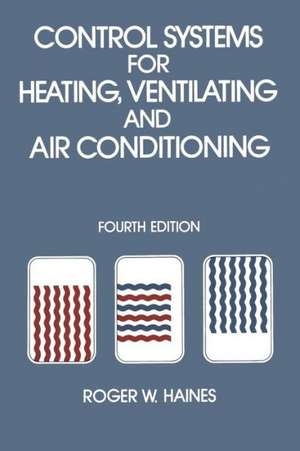Control Systems for Heating, Ventilating and Air Conditioning
Autor R. Hainesen Limba Engleză Paperback – 14 mar 2012
Preț: 389.49 lei
Nou
Puncte Express: 584
Preț estimativ în valută:
74.53€ • 78.01$ • 62.03£
74.53€ • 78.01$ • 62.03£
Carte tipărită la comandă
Livrare economică 31 martie-14 aprilie
Preluare comenzi: 021 569.72.76
Specificații
ISBN-13: 9781468465952
ISBN-10: 1468465953
Pagini: 336
Ilustrații: XVI, 318 p.
Dimensiuni: 152 x 229 x 18 mm
Greutate: 0.45 kg
Ediția:Softcover reprint of the original 1st ed. 1987
Editura: Springer Us
Colecția Springer
Locul publicării:New York, NY, United States
ISBN-10: 1468465953
Pagini: 336
Ilustrații: XVI, 318 p.
Dimensiuni: 152 x 229 x 18 mm
Greutate: 0.45 kg
Ediția:Softcover reprint of the original 1st ed. 1987
Editura: Springer Us
Colecția Springer
Locul publicării:New York, NY, United States
Public țintă
ResearchCuprins
1 Control Theory and Terminology.- 1.1 Introduction.- 1.2 What is “Control”?.- 1.3 Elementary Control System.- 1.4 Purposes of Control.- 1.5 Control Action.- 1.6 Energy Sources for Control Systems.- 1.7 Measurement.- 1.8 Symbols and Abbreviations.- 1.9 Psychrometrics.- 1.10 Relationships.- 1.11 Summary.- 2 Pneumatic Control Devices.- 2.1 Introduction.- 2.2 Pneumatic Control Devices.- 2.3 Control Cabinets.- 2.4 Air Supply.- 3 Electric and Electronic Control Devices.- 3.1 Electric Control Devices.- 3.2 Electronic Control Devices.- 4 Fluidic Control Devices.- 4.1 Introduction.- 4.2 Wall Attachment Devices.- 4.3 Turbulence Amplifiers.- 4.4 Vortex Amplifiers.- 4.5 Radial Jet Amplifier.- 4.6 Fluidic Transducers.- 4.7 Manual Switches.- 5 Flow Control Devices.- 5.1 Dampers.- 5.2 Steam and Water Flow Control Valves.- 5.3 System Gains.- 5.4 Summary.- 6 Elementary Control Systems.- 6.1 Introduction.- 6.2 Outside Air Controls.- 6.3 Air Stratification.- 6.4 Heating.- 6.5 Cooling Coils.- 6.6 Humidity Control.- 6.7 Dehumidifiers.- 6.8 Static Pressure Control.- 6.9 Electric Heat.- 6.10 Gas-Fired Heaters.- 6.11 Oil-Fired Heaters.- 6.12 Refrigeration Equipment.- 6.13 Fire and Smoke Control.- 6.14 Electrical Interlocks.- 6.15 Location of Sensors.- 6.16 Summary.- 7 Complete Control Systems.- 7.1 Introduction.- 7.2 Single-Zone Systems.- 7.3 Multizone Air Handling Systems.- 7.4 Dual-Duct Systems.- 7.5 Variable-Volume Systems.- 7.6 Reheat Systems.- 7.7 Heat Reclaim.- 7.8 Fan-Coil Units.- 7.9 Induction Systems.- 7.10 Unit Ventilators.- 7.11 Packaged Equipment.- 7.12 Other Packaged Equipment.- 7.13 Radiant Heating and Cooling.- 7.14 Radiators and Convectors.- 7.15 Heat Exchangers.- 7.16 Solar Heating and Cooling Systems.- 7.17 Summary.- 8 Electric Control Systems.- 8.1 Introduction.- 8.2Electric Control Diagrams.- 8.3 Electrical Control of a Chiller.- 8.4 Electrical Control of an Air Handling Unit.- 8.5 Example: A Typical Small Air Conditioning System.- 8.6 Electric Heaters.- 8.7 Reduced-Voltage Starters.- 8.8 Multispeed Starters.- 8.9 Variable Speed Controllers.- 8.10 Summary.- 9 Special Control Systems.- 9.1 Introduction.- 9.2 Close Temperature and/or Humidity Control.- 9.3 Controlled Environment Rooms for Testing.- 9.4 Some Examples from Practice.- 9.5 Summary.- 10 Supervisory Control Systems.- 10.1 Introduction.- 10.2 Hard-Wired Systems.- 10.3 Multiplexing Systems.- 10.4 Computer-Based Systems for Monitoring and Control.- 10.5 The Economics of Supervisory Systems.- 10.6 Benefits of the Computer System.- 10.7 Training for Maintenance and Operation.- 10.8 Summary.- 11 Psychrometrics.- 11.1 Introduction.- 11.2 Psychrometric Properties.- 11.3 Psychrometric Tables.- 11.4 Psychrometric Charts.- 11.5 Processes on the Psychrometric Chart.- 11.6 HVAC Cycles on the Chart.- 11.7 Impossible Processes.- 11.8 Effects of Altitude.- 11.9 Summary.- 12 Central Plant Pumping and Distribution Systems.- 12.1 Introduction.- 12.2 Diversity.- 12.3 Constant Flow Systems.- 12.4 Variable Flow Systems.- 12.5 Distribution Systems.- 12.6 Building Interfaces.- 12.7 Summary.- 13 Retrofit of Existing Control Systems.- 13.1 Introduction.- 13.2 Economic Analysis.- 13.3 Discriminators.- 13.4 Control Modes.- 13.5 Economy Cycle Controls.- 13.6 Single-Zone Systems.- 13.7 Reheat Systems.- 13.8 Multizone Systems.- 13.9 Dual-Duct Systems.- 13.10 Systems with Humidity Control.- 13.11 Control Valves and Pumping Arrangements.- 13.12 Summary.- 13.13 Conclusion.- Control Bibliography.- Abbreviations Used in this Book.- Symbols Used in this Book.







